Witness Confirms Arrest of Large Group of Cham People
In today’s session in front of the ECCC, Seng Srun finished yesterday’s testimony. Former militiaman Samrit Muy’s testimony revolved around the verification of information given by Seng Srun yesterday. During Democratic Kampuchea, he lived in the same village as Seng Srun. Seng Srun had testified yesterday that Samrit Muy was one of the persons who arrested him. Furthermore, Mr. Muy had witnessed how a large group of Cham people were being walked to Wat O Trakuon pagoda, where he believes they have been killed.
The end of Seng Srun’s testimony
After the Trial Chamber Greffier confirmed the presence of all parties, with the exception of the national lead Co-Lawyer for Civil Parties and with Nuon Chea participating from the holding cell, the floor was given to defense counsel for Khieu Samphan Anta Guissé to continue her examination of witness Seng Srun.
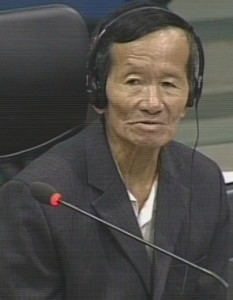
Witness Seng Srun
Ms. Guissé started her line of questioning by asking about the members of armed forces who participated in the arrest of Cham. She asked to confirm whether the five members he had mentioned yesterday were members of the armed forces. More specifically, she asked about Lav Chay (who became Mr. Srun’s brother in law later). Mr. Srun replied that he did not see him during the arrests, since they were going to different villages. Ms. Guissé then asked which of the members of the Long Sword unit he saw during the arrests of the Cham. He had seen Tay Kim Hoeun, who guided the prisoners. Due to a lack of lighting, he could not see properly who participated.
Ms. Guissé then referred to his interview.[1] He had stated that he saw members of the Long Sword Unit being separated into three groups. He recognized that they were members of the Long Sword Unit, “because they were different from us.” They carried the swords behind their backs. Ms. Guissé then queried who instructed him to lead the Cham to the pagoda. Mr. Srun replied by recounting that he was walking in the back. He insisted that he did not have any authority to lead them to the pagoda. Pressed on by Ms. Guissé, he said that, since he was at the kitchen at the time, it was the chief of the kitchen hall of Sambuor Meas Ka Village. His name was Hak Hoeun, who was the unit chief of Sambuor Meas Ka Village. When the witness arrived at the gathering point, the unit chief was not there. When he arrived at the location, he was instructed to guard the Cham. He said that he had already replied that the unit chief Hak Hoeun sent him to the assembly point. When he arrived at the assembly point, Tak Horn, the chief of the Long Sword unit, instructed him to guard the prisoners.
Ms. Guissé then referred back to Mr. Srun’s interview.[2] He had stated that the Long Sword Unit was established in June 1976. He could not recall the exact date, and repeated yesterday’s testimony that the unit was established in late 1976 or early 1977.
Exhumation of Skeletons Post ‘79
Ms. Guissé then turned to the topic of exhumation. She said that he had stated that there were no official exhumations of the pits, but that people dug them in the hope of finding goods. She inquired which goods people were hoping to find. Mr. Srun said that people hoped to find jewelry and gold. According to Mr. Srun, some discovered more than two kilograms of gold.
Ms. Guissé said that he had testified yesterday that the Cham were not allowed to practice their religion and wear traditional clothes. However, in part of his interview,[3] he had said that he had found traditional Cham clothes in the pits. Mr. Srun replied that Cham people hid traditional attire at home and did not dear to wear this attire. He did not know whether they might have worn it at home “without the view of the people.”
Next, Ms. Guissé referred to an interview,[4] where another witness had stated that it was not possible to determine who was Cham and who was not.
Mr. Srun stated that he disagreed with the statement of the other witness. “You could clearly tell” whether the skeletons were of Cham people or of Khmer people.
Members of the militia
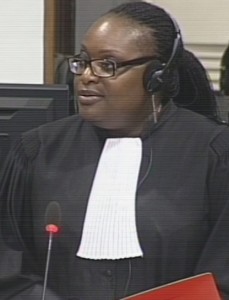
Nuon Chea Defense Counsel Anta Guissé
Ms. Guissé then asked whether it was correct that he never took part in meetings of the Long Sword Unit. He replied that he was a simple palm tree climber and “had no relationship with the members of the Long Sword group.” Neither had he any ties with the commune militia. Ms. Guissé asked whether he had no other duties than palm tree climbing, which he confirmed. He said that he did not hold any position and “was considered a reserve. They could send me anywhere they wanted to.” Ms. Guissé then asked whether it was therefore true that he was unable to know which person took decisions.
The document recovered from the jar was not a significant document. People found a jar when the dug the pits. He did not know what these documents entailed. There was no document stating that there were 30,000 people who were killed. He said that no official took the document.
In another document he had said that all members of the pagoda committee were Khmer Rouge.[5] Ms. Guissé asked to explain this. He mentioned two people who held a position on the committee. Pin Py was the chief of logistics in the commune during the Democratic Kampuchea. With this, Ms. Guissé concluded her line of questioning.
Start of a new Testimony: Samrit Muy
President Nil Nonn thanked the witness for his testimony, wished him “good luck, happiness, and prosperity for always”, and dismissed him. He then ordered to usher in 2-TCW-883.
Samrit Muy was born in 1947 in Sambuor Meas Ka Village, Peam Chi Kang Sub-District, Kang Meas District, Kampong Cham.
The National Deputy Co-Prosecutor Srea Rattanak took the floor and started his line of questioning by asking general questions at first. Mr. Muy was working at a rubber plantation before the Khmer Rouge at Peam Chi Kang Sub-District. The Khmer Rouge took power in his village in 1971. When the Khmer Rouge took power, he was assigned to work in the militia. From 1974 to 1975, he was commune militiaman. After 1975, he still lived in the cooperative and still worked as a commune militiaman.
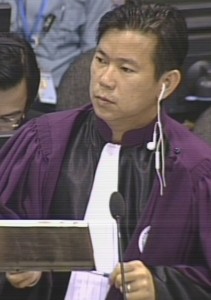
National Deputy Co-Prosecutor Srea Rattanak
Mr. Rattanak then inquired about Mr. Muy’s position and asked to clarify whether he was militiaman of the village or the commune.[6] Mr. Muy stated that he was reassigned to be part of the commune militia from 1975 onwards. He was selected by Comrade Y to work at the commune level. He was assigned to guard at night time within the area of commune administration, while he worked like other villagers during the day. In 1976, he lived in Sach Sau cooperative. Sach Sau village is adjacent to his native village. Both Khmer and Cham people were living in Sach Sau. There were more Cham families than Khmer in this village. They were “the original settlers there.”
In late 1976 or early 1977, he was sent to live in the cooperatives. At this time, the arrests of the Cham people started. In 1977, all Cham families in Sach Sau were arrested, except one husband and a wife. This included young children. The Cham were arrested all at once. He was near the kitchen hall at this time. It occurred after the arrival of the Southwest Zone group. He did not know how many people escorted the Cham. He did not know where the people who escorted the Cham people were from, since he had been too far away to identify them.
With regards to the Long Sword Group, Mr. Muy stated that it was established after the arrival of the Southwest Zone group. He did not know the members personally.
During the arrest of the Cham people, he did not see weapons. “I only saw them from a distance.” While living in Sach Sau village, they had not been aware of any plan to arrest the Cham people.
One time, they were called to attend a meeting at Damnak Svay. After this meeting, the arrests took place. All people who lived in the cooperative were called to attend the meeting. Kan, the district security person who was from the Southwest, chaired the meeting. During the meeting, they were instructed to work hard. He participated as a civilian, since he had been reassigned to work in the cooperative by then. The arrests took place around 5 pm after having returned from the field. He did not see anyone being tortured or beaten during the arrest, since he was too far away.
Wat O Trakuon as a Security Center
After the break, Mr. Rattanak inquired where the arrestees were brought to. Mr. Muy replied that the arrested Cham were brought to the Wat O Trakuon Pagoda. After the arrival of the Southwest Zone cadres, Wat O Trakuon was transformed into a security center. It was located in Sambuor Meas village. The distance between Sach Sau and the pagoda was over one kilometer. In late 1976 or early 1977, it became the Security center. He did not know where the detained people came from. Mr. Muy stated that people were sent to the pagoda to be killed. Those who were brought to the pagoda would never return. The distance between his house and the pagoda was around 200 meters.
“Whenever they wanted to kill people, they would bring people into the pagoda, and loud music would be played.” He would hear the loud music once every three, four, or five days. The loud music was played from 10 pm onwards for one or two hours. Sometimes, he could hear “sound of help”. However, he was unable to tell whether it stemmed from women or men. He would help the screaming while the loud music was being played. The kitchen where he was staying was opposite of the gate of the pagoda. On the day of the arrests of Cham from Sach Sau, the loud music was also being played. Also that night the music was played for one or two hours.
According to Mr. Muy, he did not dare to stay close to the compound of the pagoda. He did not know the name chief of the Security Center during that time, but later he heard that it was Horn. He was appointed when the Southwest Zone cadres arrived and stayed until 1979.
Geography of the Region
At this point, Deputy Co-Prosecutor William Smith took the floor. He requested permission to present a map to the witness and place it on the screen. The map was from 1993, and showed Sach Sau as well as Sambuor Meas Village A.
Mr. Smith asked whether this map was accurate. Mr. Smith then inquired how far Damnak Svay was from Sach Sau village. Mr. Muy replied that it was around one kilometer.
In late 1976 or 1977, Mr. Muy replied that he was allowed to return to Sambuor Meas A village. Mr. Smith then inquired whether it was correct that the witness only stayed in two houses during the Khmer Rouge regime: Sambuor Meas Village and Sach Sau. The witness confirmed this. The villages “joined one another”, and did not have vacant fields between them. Meas B village was adjacent to Sambuor Meas Village A. From Peam Chi Kan to Angkor Ban was around one kilometer. The witness confirmed that these villages were situated next to the Mekong River. Damnak Svay was in Peam Chi Kang sub-district. To the East of Sach Sau, there was Rok A Roy, which was in a different district than
Mr. Smith inquired whether he fulfilled his militia duties between Peam Chi Kang and Angkor Ban, which the witness confirmed. They did not have any means of transports to travel between the two locations.
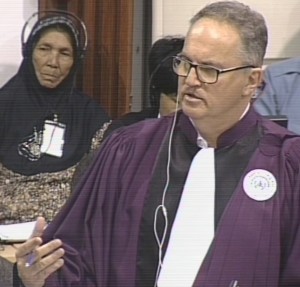
International Deputy Co-Prosecutor William Smith
Mr. Smith further asked to clarify whether Peam Stadium had existed at that time and where this was located. Mr. Muy replied that it was located in Peam Chi Kang. The distance between his home and the stadium was around 1.5 kilometers.
Turning to the meeting chaired by Kan, Mr. Smith inquired whether it was correct that Kan came from the South. Mr. Muy confirmed this. He was the district secretary from Kang Meas. Mr. Muy could not recall a meeting at Peam Stadium and stated that he did not attend it. Mr. Smith then asked whether he attended a meeting with both Sector Committee An and District Committee Kan attending, which the witness denied.
Mr. Smith then read out an excerpt of the witness’s interview in which Mr. Muy had talked about a meeting at Peam Stadium. [7] At this meeting, according to the interview, it had been said that “there were enemies amongst the people.” Mr. Muy replied that he attended a meeting that all villagers attended. Kan was present, but he was not sure whether An attended. When Smith asked whether Kan had said that there were enemies amongst the people, Mr. Muy confirmed this. However, Kan had not specified who these enemies were. Mr. Smith asked whether Kan came from Kang Meas District. Mr. Muy replied that Kan came from the Southwest, but he did not know from which part.
The Arrival of Southwest Cadres
The Southwest cadres came at the end of 1976 or beginning of 1977. They took authority in the district. The cadres who previously had held the positions had been, although he was unsure about this, arrested and killed. He reached this conclusion because the cadres disappeared. “Everyone in the regime knew that disappearance meant death.”
Turning to his next topic, Mr. Smith asked how long the witness had lived in Sach Sau during Democratic Kampuchea. Mr. Muy replied that he lived most of the time in Sambuor Meas Village A. Sometimes he stayed for a fortnight in Sach Sau. Then he would go back to Sambuor Meas for a night, before returning to Sach Sau.
Mr. Smith then turned to Mr. Muy’s statement that “the arrests accelerated night and day” after 1977 and asked for explanation how the witness knew this. Mr. Muy replied that he observed this from the distance. He could see people being transported when having lunch or dinner. Loudspeakers would be played afterwards.
The Long Sword Group
After the lunch break, the floor was again granted to the Co-Prosecution. Mr. Smith turned to the topic of the Long Sword group. He inquired how many members the Long Sword group had. The witness replied that he did not know the number. “As I said, I did not dare to approach them.” Neither knew the witness whether the Long Sword group was operating in the whole district.
Mr. Smith asked whether it was correct that Mr. Muy ate in communal dining halls from 1975 onwards. For a period of two years, he ate his meal in a communal kitchen that was created for Sambuor Meas village. He did not know where the Long Sword unit members ate their meal. He ate his meal together with workers from his cooperative. After the end of the regime, some members of the Long Sword unit had been arrested and killed.
Mr. Smith inquired whether the witness knew Tay Kim Hoeun, which Mr. Muy confirmed. He got to know him in 1977 when Tay Kim Hoeun came to work in his cooperative. He had never seen this person in the Long Sword Group.
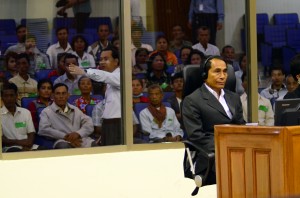
Witness Samrit Muy (ECCC Flickr)
Next, when Mr. Smith started reading out an excerpt of another witness[8] Ms. Guissé objected to the use of the document, since it had not been tendered into evidence. Mr. Smith replied that it was a document on this case file. Whether the document would be admitted later was another question. Asked for clarification by Judge Jean-Marc Lavergne, Mr. Smith said that it was certainly disclosed to all parties, but he was not sure about the status of admission.
Ms. Guissé then said that when the documents had been disclosed to them, but had not been subject to a request for admission, this would not be sufficient to use it in front of the Chamber. This document had not been part of a 87(4) request.
Judge Claudia Fenz asked what the substantive reasons of the objection were, since in exceptional circumstances a document could be admitted if no party objected. Ms. Guissé replied that she did not quite understand the nuance of this question. Judge Lavergne rephrased the question and asked whether he understood it correctly that the substantive reasons were part of the written motion filed by the defense team. Ms. Guissé replied that her reasons were subject to the written motion.
Mr. Smith stated that the disputed document was highly important, since it stemmed from a person who worked at security center. According to Mr. Smith, this presented a unique opportunity to confront this witness, since both covered common points. The Co-Prosecution will file a 87(4) request that includes this document. In Mr. Smith’s eyes, this unique opportunity was more important than procedural aspect. Mr. Koppe interjected and reminded the Court that last week, the Co-Prosecution had objected to his use of a Human Right Watch Report. He stated that this was the same situation. After the judged briefly conferred, the objection was sustained. The Co-Prosecution had not submitted a request of 87(4). Moreover, the document was subject to an objection by the defense teams that was pending in front of the chamber.
Mr. Smith then moved on and asked whether prior to 1977, the only combatant unit in the commune were the sub-district militia. Mr. Muy answered that there were only militiamen and no Long Sword group yet. He confirmed that he had been part of the militia prior to the arrival of the Southwest Zone cadres.
The arrests of Cham and cadres
Asked about arrests of Cham people in other areas, Mr. Muy replied that he had no knowledge concerning other areas.
No Cham were living in village Sambuor Meas A. Cham were living in Sach Sau. While Mr. Muy was staying with the Cham people in Sach Sau, “Cham people were allowed to worship their religion every once in a while.” When the Cham people were arrested, he had already left the village. He did not know the reason why he was removed from the militia to the cooperative. The commander of his militia unit were Nam and Y. However, these were taken away and killed later. There were 12 members in his unit, including some Cham people.
Mr. Smith then inquired by whom these two people were killed, which the witness did not know.
Mr. Smith then asked what the witness believed had happened to the arrested cadres. Mr. Koppe objected to the question, since it was “not relevant what the witness believed”. Mr. Smith rephrased the question and asked whether the witness knew that they had been killed by the Southwest Zone cadres, which the witness confirmed. He drew this conclusion, because they disappeared after the Southwest Zone cadres arrived.
Mr. Smith inquired whether, when these two militia chiefs had disappeared, Mr. Muy had been appointed as a head of the commune militia. Mr. Muy replied that he had been reassigned to the cooperative at the time and that he did not know who replaced the two leaders because of this.
Mr. Smith inquired who reassigned him. Mr. Muy replied
Mr. Smith pressed on and asked who reassigned him to work in the cooperative when the two leaders had gone. Mr. Muy replied that the two leaders had not left yet when he was assigned to live and work at the cooperative. It was they, Y and Nam, who reassigned him.
When Mr. Smith started reading an excerpt of yesterday’s witness without naming him,[9] Ms. Guissé stated that he should be named. Mr. Smith did so and asked Mr. Muy whether he knew Seng Srun and how. Mr. Muy replied that he did and that he knew him, because they lived in the same village. Reading out the excerpt, Mr. Smith asked Mr. Muy to comment on the statement that Mr. Srun alleged that Mr. Muy had been a militia unit chief from 1973 onwards.
Mr. Muy replied that he was guarding the village with bow and arrow, but he did not hold any position in the commune militia. “I was simply a member of the militia group.”
Mr. Smith then asked whether it was true that Mr. Muy was involved in the arrest of Mr. Srun, which Mr. Muy denied. He stated that Mr. Srun was arrested and re-educated, but that he had neither been involved in the arrest nor the release.
When Mr. Smith asked whether arrests took place after the liberation of Phnom Penh, Mr. Koppe interjected and stated that this was “difficult to answer”, since the witness’s area had been liberated substantially earlier. Mr. Smith asked whether the witness knew which year Phnom Penh was liberated. Mr. Muy replied that this took place in 1975. Mr Smith then asked again whether after this point in time, arrests increased. Mr. Muy replied that people were taken to O Trakuon Pagoda.
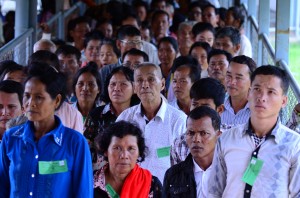
Visitors at the Extraordinary Chambers in the Courts of Cambodia on 15 September 2015 (ECCC Flickr)
“I knew in my heart that people were taken away and killed.” He did not know who killed the people in his area. In 1976, he lived with the Cham people. Only upon the arrival of the Southwest group, Cham people were killed.
Starting from 1975, the security forces conducted the arrested. “In the commune, as Seng Srun testified, the person would not be alive.” Mr. Muy stated that he brought food to Mr. Srun while he was in prison. With this, Mr. Smith finished his examination of the witness.
Relation of Seng Srun and Samrit Muy
Since the Civil Party Lead Co-Lawyer did not have any questions, Mr. Koppe was granted the floor. He asked whether Mr. Seng Srun had not been telling the truth about his arrests when implicating Mr. Muy of arresting him. Mr. Muy confirmed this. “I gave him food, and this is why he survived.”
Mr. Koppe then asked whether Mr. Srun and Mr. Muy were neighbors, since both houses were around 200 meters away from the pagoda. Mr. Muy replied that Mr. Srun’s house was 200 meters to the West, while Mr. Muy’s house was 200 meters to the east of the pagoda.
Mr. Koppe then inquired about Mr. Srun’s position in the village. Mr. Muy stated that Mr. Srun was an ordinary citizen, but that he did not pay attention to particular assignments given to individuals. Thus, he did not know whether Mr. Srun was assigned to climb trees.
Mr. Koppe asked whether Mr. Muy had ever seen Mr. Srun climb a palm tree. Mr. Muy stated that people had to carry out whatever assignments they were given under the Khmer Rouge regime.
Mr. Muy stated that to his knowledge, Mr. Srun was not involved in the arrest of Cham people. “We civilians did not have anything to do with the Cham people.”
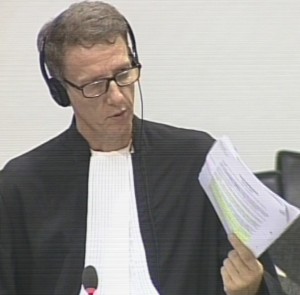
Nuon Chea Defense Counsel Victor Koppe
When Mr. Koppe pushed further and stated that Mr. Srun had stated that he “had been instrumental” in the arrest of the Cham people, Mr. Smith interjected and stated that it was not an accurate summary. The Defense Counsel should read an excerpt.
Mr. Koppe did so, and read an excerpt of one of Mr. Srun’s interviews, where he had stated that he had been asked to lead 200 to 300 Cham to the Wat O Trakuon pagoda.[10]
Mr. Smith further objected to the question, since Mr. Muy had stated earlier that he did not know who partook in the arrests. Mr. Koppe replied that given the involvement of the witness and his knowledge about the commune militia, this was an appropriate question. The objection was overruled.
Mr. Koppe read out the excerpt again and asked Mr. Muy to react. Mr. Muy replied that he witnessed the arrest of a large group of Cham people, but he did not know whether Seng Srun was leading the group of Cham people. He could see that Cham people were being walked to the pagoda, but could not evaluate the statement given by Seng Srun.
Mr. Koppe then turned to the friend Mr. Srun had mentioned yesterday: Moeun. Mr. Muy stated that he knew Moeun who worked within the security unit. According to Mr. Muy, Moeun’s birthday place was in Peam Khnom. Mr. Muy stated that this person worked exclusively in the guard area and never worked as a palm tree climber. “I could vouch for it that he was not a member of the palm tree climbing unit.” Moeun “was vicious and he would take people to be killed”. Hence, Mr. Muy avoided Moeun.
At this point, the President adjourned the hearings for a break.
Security Guard Moeun
After the break, Mr. Koppe inquired whether he had ever seen Moeun in the company of Seng Srun, which Mr. Muy denied. Neither did he hear after 1979 that Moeun and Seng Srun had been friends in the Democratic Kampuchea period. Mr. Koppe said that Seng Srun had testified that Moeun was a palm tree climber and that Moeun had told Seng Srun about the killings. Mr. Muy said that he did not know of the relationship between Seng Srun and Moeun.
Next, Mr. Koppe turned to ask about specific persons. Mr. Muy did not know who the Security Chief of Sector 41 in 1975 until the beginning of 1977. Mr. Muy also could not recall someone called Sorng. Mr. Koppe further inquired whether he knew the predecessor of Kan, which Mr. Muy denied. Mr. Koppe then asked whether Mr. Muy knew Chhoeun Ol, alias Meas. Mr. Muy answered this in the negative.
The Role of An
Next, Mr. Koppe asked who the Secretary of Sector 41, so An’s predecessor, was. Mr. Muy stated that he did not know, since they would only hear about the Secretary of 41, but would not know the person. This prompted Mr. Koppe to ask about the arrest and killing of North Zone cadres. He inquired how Mr. Muy knew this, to which the witness responded that he believed that they were all killed, because they saw suddenly all disappeared.
Mr. Koppe then inquired whether Mr. Muy ever witnessed any killings, which Mr. Muy denied.
Next, Mr. Koppe asked about the meeting in which Ta An allegedly attended. He queried whether the witness had ever heard of Ta An speaking in a meeting about former Secretary of Sector 41 Koy Toeun, which Mr. Muy denied. During this meeting, they were instructed to work hard.
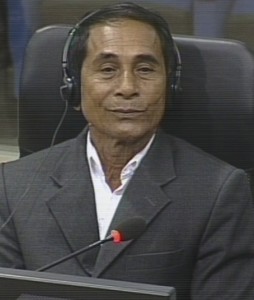
Witness Samrit Muy
Further, Mr. Koppe asked how Mr. Muy knew that the person who spoke at the meeting was called An. The witness replied that the person presented himself with his name and as being chief of the sector. An spoke about the enemy of the people. Mr. Koppe further wanted to know whether An made reference to cadres of Sector 41 who had been arrested. Mr. Muy said that he did not hear this announcement, but “heard about the infiltrated enemies.” Later, he heard that innocent people were arrested. Mr. Koppe asked how he knew that the cadres who were arrested were innocent. Mr. Muy replied that he did not say that these people were innocent, but he witnessed the arrests and killings of innocent people.
When Mr. Koppe asked whether the statement that the cadres had been killed were speculation, the President intervened and instructed the witness not to answer the question. He stated that this was a leading question.
Mr. Koppe further inquired whether An had asked about the Cham in this meeting. Mr. Muy said that this was not the case, but that the Cham were later arrested after the meeting.
Mr. Koppe turned to his next question and asked whether after the arrival of Southwest Zone cadres in 1977, Mr. Muy had looked into the pagoda compound. Mr. Muy denied this. Mr. Koppe asked whether Mr. Muy had ever asked about delivery of food for prisoners. Mr. Muy replied that he had never heard of this. Mr. Koppe then inquired whether Mr. Muy had seen skinny prisoners. Mr. Muy said that he only saw prisoners being walked there, but did not dare to go close to the pagoda.
As regards loud music being played while people being killed, Mr. Koppe asked whether Mr. Muy knew this at the time or only afterwards. Mr. Muy replied that he knew “back then in [his] head” that people were being killed. After the arrests, there were no Cham living in his village anymore. Mr. Koppe turned to his last question and asked whether the killing of Cham was a conclusion that Mr. Muy reached without actually knowing it.
Nuon Chea Defense Counsel Liv Sovanna stated that he had three questions.

Nuon Chea Defense Counsel Liv Sovanna
First, he inquired at what time he saw the Cham people being walked to the pagoda. Mr. Muy replied that he did so when he was having dinner. Mr. Muy said that it was “not really dark yet.” They usually had dinner between 5 pm and 5.30 pm. When he saw the Cham being walked, it was between 5 pm and 6 pm.
Mr. Sovanna then confronted Mr. Muy with Seng Srun’s statement that Moeun was not a vicious killer and only accompanied the killers.[11] The President interrupted the question and informed the witness that he did not need to answer this question.
Mr. Sovanna further asked whether he knew the reasons for the arrests of Mr. Seng Srun, which Mr. Muy denied.
At this point, the floor was given to the defense team for Khieu Samphan. Ms. Guissé started her questioning by asking about Mr. Muy’s personal history. She referred to his interview, in which Mr. Muy had indicated that he had left school in the 9th year, because his parents were poor.[12]
Ms. Guissé asked what age and education the 9th year corresponded to in the Khmer system. Mr. Muy replied that he was 15 or 16 years old. After quitting school, he became a worker at the rubber plantation. Ms. Guissé asked to confirm that the period when many teenagers were working at the rubber plantation was before 1971. Mr. Muy replied that he worked there from 1964 “until the “B-52 bombings” started.
He did not know which Zone his village was located in. Ms. Guissé asked whether she understood the testimony correctly that he was a militiaman from 1973 until 1975, which the witness confirmed.
In mid-1976, he was reassigned to be a commune militiaman. While he was a commune militiaman, his chiefs were Y and Nam. Ms. Guissé inquired whether he knew someone called Run, which Mr. Muy denied.
Back to the Long Sword Unit
Ms. Guissé then asked whether he remembered people who were part of the Long Sword unit. Mr. Muy replied that he did not dare staying near them and did not members of the group. Ms. Guissé further inquired whether he knew someone called Lav Chay, which the witness denied.
He knew Meng Ly, since this person was living in his village during Democratic Kampuchea. He stated that “all he knew” was that Meng Ly was member of the Long Sword Unit. He was working and building the dam.
Further, Mr. Muy knew Heng Pha. He did not know where this person came from. He also knew Yeun, who was living in his village, but he did not know what he did at the time. Mr. Muy stated that he did not know whether Tay Kim Hoeun was part of the Long Sword group. Tay Kim Hoeun’s home village was in Angkor Ban.
Arrests of the Cham
Turning to the topic of arrests, Ms. Guissé asked whether he witnessed arrests carried out by the Long Sword group. Mr. Muy said that he never witnessed such an incident. As for the arrests of Cham people, Mr. Muy repeated that he could not see who lead the group. He confirmed that he was in the kitchen of his cooperative when he saw the Cham people walking to the pagoda. This kitchen was around 300 meters away from the pagoda.
She asked whether he could not see who escorted the group of Cham people, even if he was just 300 meters away. Mr. Muy confirmed this.
Ms. Guissé read out two excerpts of yesterday’s session.[13] Mr. Srun had testified that Mr. Muy had arrested him. Ms. Guissé asked whether Mr. Muy participated in the arrests, which Mr. Muy denied. He had no authority to arrest Mr. Srun. Further, Mr. Srun stated that Mr. Muy held this position from 1973 until 1979, before fleeing to Chamkar Leu. She confronted Mr. Muy with this excerpt and asked him whether he was not a militiaman until 1979. Mr. Muy stated that he was a militiaman until 1977, and not longer. Ms. Guissé asked Mr. Muy to explain why Mr. Srun would be lying to the Chamber and whether Mr. Srun “had any problems” with Mr. Muy. Mr. Muy could not shed much light on this matter. Ms. Guissé then asked whether there was any reason for Mr. Srun to lie to the Chamber.
Ms. Guissé asked whether it was true that after 1977, he did not attend any meeting within the commune or militia, which Mr. Muy confirmed. She asked him to confirm that he did not have access to information that was held by the security, commune, or sector level after 1977. The witness replied that this was true.
Ms. Guissé turned to her last question by asking when he had met the investigators of the OCIJ. He stated that he could not recall the day of the first interview. He was informed that he would be appearing in front of the Chamber in October. It was not an interview.
At this point, Mr. Kong Sam Onn took the floor and asked when the arrest of the Cham people occurred. Mr. Muy replied that he could not recall this.
He asked about the Written Record of Interview of the witness, who had said that the Cham people were arrested in late 1976 or early 1977.[14] In today’s testimony, Mr. Kuy had said that this occurred in 1977. Mr. Muy said that he could not remember the exact time when this incident occurred.
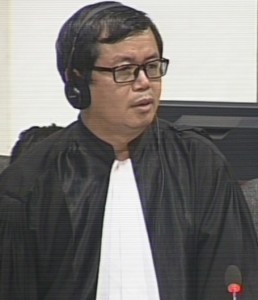
Khieu Samphan Defense Counsel Kong Sam Onn
Mr. Sam Onn then inquired whether he knew how many Cham people were arrested. Mr. Muy stated that all Cham of his village were arrested, but did not give a number.
From 1977 until 1979, “not only Cham people were killed. Khmer people were also killed. Pregnant women and children were taken away and killed.” He was unaware of killings and arrests in other villages, since he did not go there. Mr. Muy confirmed that there were more Cham people living in Sach Sau than Khmer people before the arrest.
Mr. Sam Onn asked how Mr. Muy knew that all Cham people were arrested from Sach Sau. Mr. Muy replied that this was, because no Cham people were living in Sach Sau anymore. He stated that only one couple could flee, since “they were hiding in the lake.” Mr. Sam Onn inquired how he knew that no more Cham were living in the village. He did not go to Sach Sau after the incident.
At this point, the President adjourned the hearing, thanked the witness and dismissed him. The hearings will continue tomorrow, September 16 at 9 am.
[1] E3/5252, at 00269892 (FR), 00235517 (EN) 00235022 (KH). [2] E3/5252, at 00269891 (FR), 00235021 (KH), 00235516 (EN) [3] E3/5302, at 006223193 (FR), 00635179 (KH), 00210490 (EN) [4] E3/2654, at 00620050 (FR) , 00211169 (EN), 00640495 (KH), [5] E3/5252, at 00269891 (FR), 00235021 (KH), 00235517 (EN) [6] E3/9346, at 00235015 (KH) 00235507 (EN) 00283947 (FR). [7] E3/9346, at 00235508(EN), 00235016 (KH), 00283948 (FR). [8]E319/19.3.93, at01035843 (EN), answer 15 [9] E3/5252, at 00235516 (EN), 00269890 (FR), 00235021 (KH). [10] E3/5302, at 00210488 (EN), 00635176 (KH), 00623191 (FR). [11] E3/5302, at KH p.7, 00210489 (EN), 00623192 (FR). [12] E3/9346, at 00283946 (FR), 00235507 (EN), 00235014 (KH). [13] Transcript of September 14 2015, at 15:40 and shortly before 15:54. [14] D166/26, at 00235015 (KH), 00235508 (EN), 00283947 (FR).
